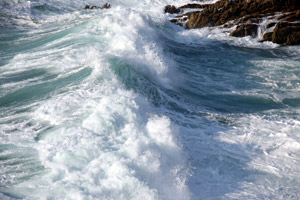Tidal Power as a Source of Inexhaustible, Clean Energy
Download Audio VersionTidal power is the energy of tides that is used to generate electricity. There are innovative technologies to generate power from salinity gradients, ocean winds and currents, ocean thermal energy, and wave and tidal power.
Tides
A tide is formed by the fall and rise of sea levels and as a result of the combined effect of the Earth’s rotation and the gravitational pool of the sun and moon. There are areas with one low and one high tide daily while others have two low and two high tides. Near tides also occur when the moon and sun generate forces that act at a certain angle. Currents occur as a result of salinity and temperature differences and winds. Currents generated by tides are more suitable for electricity production than wind-generated currents because the former are faster. Locations that experience strong currents include the Straits of Messina, the west coast of Canada, South East Asia, between France and the Channel Islands, and around Ireland and the British Islands.
Technologies and Equipment

Tidal energy is produced by underwater turbines and generators that work to capture kinetic motion. In addition to conventional hydropower systems, vertical-axis hydroelectric turbines have been installed and tested. In general, the equipment used is similar to that employed in hydroelectric power plants. A barrage or dam is built across an estuary or bay. Turbines and gates are placed along the dam. Gates open when significant differences in water levels occur. The sluice is closed when the tide flows in and sea level falls. Besides traditional technologies, researchers also attempt to capture energy in flow streams.
Tidal power can be used in the form of ocean thermal, tidal, and wave energy. The process of ocean thermal energy conversion uses differences in water temperature. Another way in which tidal power is used is by focusing or bending waves to direct them to a channel. This is done to increase their size and power. Waves are also used to drive turbines or directed to a catch basin. Some small wave energy plants also operate to produce electricity. Japan is one of the countries with a wave energy strategy.
Benefits and Downsides to Using Tidal Power
This is a source of clean, renewable energy which has a positive impact on the environment because it generates no carbon dioxide emissions. Moreover, dams and barrages can be used to protect ports and coastal towns and areas against storms and high tides. One problem is the high costs associated with technologies required for harnessing tidal power. This makes them less competitive compared to alternative sources and technologies. Another problem is that tides are an intermittent rather than constant source of energy. Finally, the facilities used to generate power may disrupt marine life because large turbines and frames are used. Fish migration could also be disrupted with the erection of facilities. Further research is required to develop more efficient technologies to use this valuable source of energy. Tidal power is abundant, inexhaustible, and environmentally friendly. The goal is to find ways to limit the risk of operational hazards. Another problem is the fact that it is difficult to find good locations to construct facilities. The locations that are optimal for energy production are found in coastal areas only.
Many western countries have developed policies to diversify their energy mix and obtain 20 percent of their electricity from clean and renewable sources. The goal is to reduce greenhouse gas emissions by up to 80 percent. In the United Kingdom, for example, tidal power has the potential to create thousands of jobs, save huge amounts of carbon dioxide, and power around 15 million homes. Other locations with tidal energy capacity are South America, Canada, the Channel Islands, France, New Zealand, Australia, Japan, China, and Korea. The United Kingdom has the largest capacity in Europe, with an estimated supply of over 10 GW.
Related Articles
Sustainable Energy Sources as a Safe Alternative and the Source of Clean Electricity
There are different sources of sustainable energy, including thermal, solar, wind, and ocean power. In general, alternative energy is produced by exploiting sources that are different than fossil fuels such as petroleum and coal. Ecologically friendly sources help reduce carbon dioxide emissions...
Wave Power as a Way to Meet Global Energy Hunger
Wave power is used for pumping, water desalination, generation of electricity, and more. Due to its high power density, researchers view it as one of the least expensive sources of renewable energy to be used in the foreseeable future. According to the World Energy Council, wave power could account...
Geothermal Energy as a Clean Source That Reduces Dependence
Geothermal energy is in the form of heat that is found and used in different locations, from Iceland and Italy to Japan and Kenya. It is used to heat office buildings and residential units. Geothermal energy is produced by pumping systems, large power stations, and other types of technologies. This...


